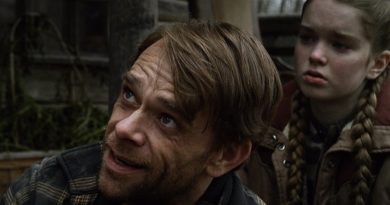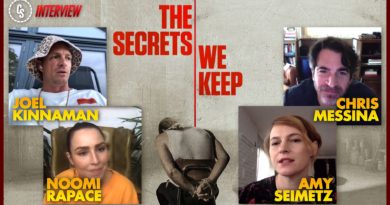CS Interview: Loretta Devine on Return to Horror in Spell
CS Interview: Loretta Devine on Return to Horror in Spell
ComingSoon.net got the opportunity to chat with Emmy winner Loretta Devine (Grey’s Anatomy, Sierra Burgess is a Loser) to discuss her return to the horror genre for the hoodoo pic Spell, which is now available available on digital platforms!
RELATED: Spell Review: Too Deliberately Paced But Well-Performed Hoodoo Thriller
ComingSoon.net: So it’s been a while since we’ve seen you in the horror genre, I think since you were Officer Reese in the Urban Legend movies. What was it like returning to the genre?
Loretta Devine: Oh my god. I hadn’t thought of that movie in so long, but this is really a lot different from that [laughs]. I was the good guy in the Urban Legend movie. This time, I’m not such the good guy, I guess I should say. I think the villain is always the one that’s remembered the most, so I think it was very exciting. It was exciting to do because it’s so different from the genre that I’m used to. But I still played a character that had conviction, and this is a woman, Eloise is a practitioner of root work. And she believes herself to be no different from a doctor. So, to me, she’s a good guy, really, but she has very negative motives because it’s the time of the blood moon, which increases your magical powers tenfold, and she has the perfect candidate to do some of the things that she wishes to do for herself. I don’t want to give away the plot. I think the thing that’s the most scary about the film is that it’s really based on the black people that live in the Appalachian mountains and the character that has a definite history that comes out of slavery and has a lot to do with the fact that there is not enough money to get actual doctors. So, these are some of the sort of practices that they use because of the amount of poverty that’s in that region and that there is an amount of truth to it. They use something that is called hoodoo, and hoodoo is American magic. It’s not the same as voodoo, which is a Haitian, African form of witchery and craft. This is called root work, which has to do with the soil and herbs and casting of spells and it also has a great amount to do with what the people believe to be true. So she’s able to give people their sight back and to give them their voice back by using dolls called Boogitys.
Click here to purchase the horror-thriller!
CS: That’s one of the things I really loved about the film, is how expansive it was on the hoodoo culture, which I feel is something we haven’t really seen too much in film before. Were you very familiar with it prior to joining the film?
Devine: Well, I’m from down south and my family picked cotton in Richards, Texas and there were stories. I had heard some of the things that I found out before I did the movie that were actual things that were believed in my family. For instance, if a baby is born with a cowl, which is like a veil over their face, they were considered to have special powers or be able to see things into the future that other people couldn’t see. My character in this script was born that way and they threw her in the river, but she didn’t drown. So other runaway slaves found her and she was taught how to become a root worker. So it is an actual prayer that some of the people believe in and know how to manifest. So I had heard of some of it before, which made it even more scary for me. Also, we shot this in South Africa in Cape Town, and that was scary, too.
CS: Yeah, the farm has such a nice, rural feeling to it, what was it like shooting at that location?
Devine: Well, Mark Tonderai, the director and the writer, they setup the bible that had a view of what the place should be. We filmed most of the story in this attic that was also in one room and had been built into the sky that was connected to a house and a farm area, which is what you see there. It’s built way out in the woods in South Africa in a winery district, which was about an hour’s drive from where we were living, where we were staying in Cape Town. It was very hard because everybody had to go up and down these stairs to get to the main area that we were filming in and sometimes we would be in this very small room, with over 30 people, which would include all of the camera people and the actors and you know, the people with the costumes and the makeup and everything had to go up and down these stairs for everything. It just created a certain kind of tension and weariness I think that made the movie even better.
CS: So you mentioned that you don’t necessarily perceive her as the villain, but what would you say were some of the biggest creative challenges for you getting to the heart of this character that we haven’t really seen you play before?
Devine: Well, mostly the characters that I play are always very sweet mothers. I don’t think I played many villains, even when I was in Urban Legend, I was the good person. So it was a challenge, I think, first of all, I don’t think the people at Paramount really thought it was something I could do because they’d only seen me in very gentle types of roles. The director was the one that said, “Oh no, I saw her on Family Reunion, and when she whooped that boy, I think that’s exactly what I need for this movie.” So he used the timber of my voice and my kindness, I think, as a setup for all of the things that come later in the movie.
CS: So then what was it like building the rapport, the antagonistic rapport with Omari, who I mean, you’ve worked with before and who was telling me that you two were already friends prior to the film?
Devine: See, what you call antagonist to me, I think of everything from my character was very honest. I honestly didn’t mean him any harm, and I honestly felt that everything that was done in the movie was for the good of the community and for the good of my livelihood, which is how most people function. So I don’t think there was anything done in a sinister way, until maybe the very, very end, maybe. That’s what I can say about how I felt about it. I knew Omari from his work more than from personally seeing and knowing him. We live in different states, so we’ve seen each other at awards shows and benefits and things like that, but I didn’t like, know him, know him. I just knew he was fine and that all the women were going to wish they were locked in a basement with him, also an attic. So that’s all I can say, and it really helped the movie that he has his shirt off half the time [laughs].
CS: What was it also like building the rapport with John Beasley as Earl? Because I mean, even though he doesn’t quite have as much screen time as you and Omari, he still feels like a pretty vital person.
Devine: I played John Beasley’s wife before, I think twice in two different television shows. So I knew John Beasley, I’m closer to John than I was to Omari because I knew John better from all of the years of working with him. We also have the same agent and manager, so it was wonderful to work with him. John is very down to earth and very straightforward. He tells you exactly what he thinks without any qualms. I got a chance to spend time with him, his wife and family. We did a lot of sightseeing together on our days off. So that part of it was really, really wonderful.
CS: That’s great. So, you have so many moments to steal the scene throughout, what would you say was your favorite scene to get to perform throughout the film?
Devine: Oh god. There was one speech that I had to give, explaining why she thought root work was so important for her community. I really worked so hard on that speech. There were so many long, long speeches in this thing that took so much time to learn and then to actually do because when you do them over and over, they have to be exact. That was so hard. But the hardest part was not knowing whether or not it would actually make it into the film, you know? So I think the moment where we did, where Omari discovered the bones that I was having him throw and the speech that went with it, that was one of my favorite moments in the film, besides the very ending, where they do what they do to me [laughs].
CS: When I talked to Omari, he even mentioned that there was just a minimal bit of improv going on between the two of you. Did you find that you got to improv a little bit here and there as well?
Devine: I can’t remember—well, in the church scene, there was a lot of improv, and they cut a lot of that out, too, because there was a lot of singing and at one point I think they had John Beasley doing a sermon. I don’t think the sermon made it. A lot of those things were improv’d because it was such a huge church thing and they had no dialogue for that. But they wanted it to be happening. So we just went for it.
RELATED: CS Interview: Omari Hardwick on Horror-Thriller Spell
While flying to his father’s funeral in rural Appalachia, an intense storm causes Marquis (Omari Hardwick) to lose control of the plane carrying him and his family. He awakens wounded, alone and trapped in Ms. Eloise’s (Loretta Devine) attic, who claims she can nurse him back to health with the Boogity, a Hoodoo figure she has made from his blood and skin. Unable to call for help, Marquis desperately tries to outwit and break free from her dark magic and save his family from a sinister ritual before the rise of the blood moon.
Alongside the Power alum and This Christmas star, the cast for the film includes John Beasley (The Sum of All Fears, The Immortal Life of Henrietta Lacks).
The film is written Kurt Wimmer (Children of the Corn, Law Abiding Citizen) and directed by Mike Tonderai (House at the End of the Street, Locke & Key) and is produced by Morris Chestnut (The Resident, The Enemy Within), Gordon Gray (Most Dangerous Game, The Way Back), Janine van Assen (Tomb Raider, Serenity), Brian Wilkins (Darrow & Darrow, Lost in America) and Wimmer.
Spell is now available on video-on-demand and digital platforms from Paramount Home Entertainment!
Courtesy of: comingsoon.net



